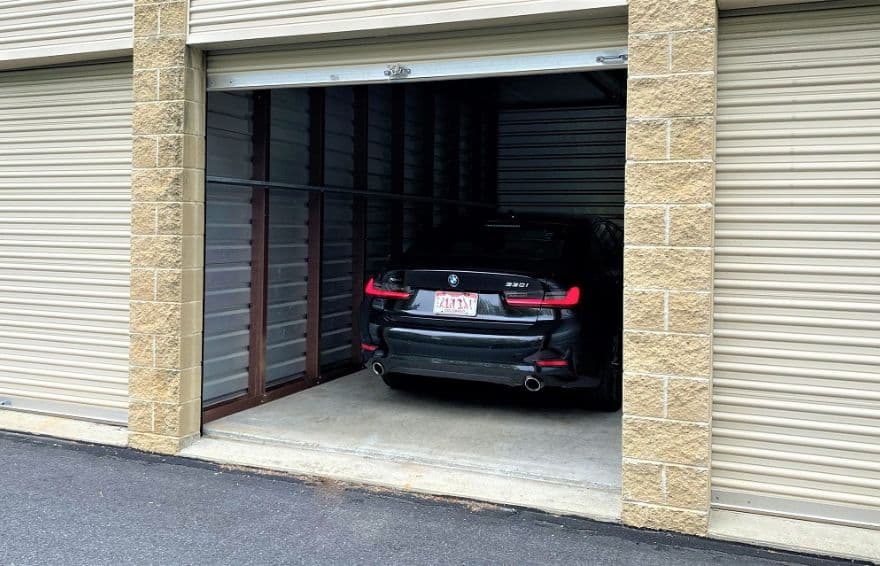How to Store a Car for an Extended Period of Time
When it comes to storing your car for an extended period, there really is more to it than just parking it in a safe spot and walking away. Whether you’re leaving your vehicle for a few months while traveling or for longer periods due to seasonal changes, proper preparation and storage techniques are essential for keeping your car in top condition.
In this guide, we will walk you through the best practices on how to store a car, ensuring that you’re ready to hit the road again in a vehicle that is just as good as the day you left it. From choosing the right storage environment to protecting vital components like the tires and battery, we will provide you with all the information you need to store your car safely and securely.
Inside versus Outside Car Storage
When deciding between indoor and outdoor car storage, it is important to consider your specific needs and preferences overall. An open-air, fenced storage facility might be good enough for some vehicles. However, if protecting your car from the elements, debris, and unauthorized access are all important to you, then indoor storage is the better option.
For a classic or high-value vehicle, for instance, indoor storage is essential. In this case, you want to rent a climate-controlled unit with temperature and humidity regulation year-round. This safeguards your car from potential damage caused by extreme changes in weather.
Accessibility Considerations
Whether you are storing your car seasonally or need regular access for a work vehicle, you want to pay close attention to the following features at your preferred storage facility:
- Driveway Width: You want to make sure that the driveways are wide enough to allow for easier maneuvering of your car.
- Ceiling and Door Clearance: Make sure that your car can fit comfortably into the storage unit without risking any damage
- Entry Threshold: Check that the threshold allows safe entry and exit without scraping or scratching the undercarriage of your car
EZ Storage offers extra wide driveways and has a thoughtful design that makes storing and accessing your car hassle-free.
Preparing Your Car for Long-Term Storage
Another thing to think about when learning how to store your car is what kind of preparations you need to follow through with before leaving it in storage.
- Fuel Management: Either fill your gas tank completely or drain it to minimize any fuel-related issues. A full tank of gas helps prevent moisture build-up while it is being stored while draining the tank eliminates any chance of fuel degradation.
- Battery Care: Disconnect the battery to preserve its charge. If possible, use a battery maintainer to keep it in good condition over time.
- Fluid Leaks: Address any existing oil or fuel leaks there may be. You also want to place a protective layer like cardboard under the car to catch any potential drips and simplify the cleanup process when you go back to get your car.
- Cleanliness: Thoroughly clean your care inside and out before storing it. You want to remove any food items or debris that could possibly attract pests while you’re away. If you are storing your car outdoors, cover it with a high-quality tarp to shield it from rain and other environmental factors.
Insurance Considerations
Even when your car is placed in storage, you still want to maintain the insurance on it. While you might not need full coverage, discuss your options with your insurance agent and see if you can reduce the amount of coverage you have to save some money while still ensuring your car is protected.
Additionally, if you are renting a storage unit, note that your lease likely doesn’t include insurance coverage. Make sure to tell your insurance agent that the car will be stored away from the home so they can adjust your policy as needed.
Security Measures
When selecting a storage facility for your car, you should prioritize security. Find a location with gate-controlled access and one with a strong reputation for safety. Convenient hours and location are also two more important factors to keep in mind.
Review online feedback to gauge the reliability of the facility or ask your neighbors for their recommendations.
How to Store a Car for Three Months
Short-term storage, like three months, still requires a fair amount of planning.
- Fuel Stabilizer: Add a fuel stabilizer to prevent the gas in the tank from breaking down and causing engine issues.
- Tire Pressure: Inflate your tires to the recommended pressure to prevent flat spots
- Start the Engine Occasionally: If possible, start the car at least once a month and let it run for a few minutes. This keeps the engine and other mechanical parts in good working order.
How to Store a Car for Six Months
For storage for up to six months, take these additional precautions:
- Change the Oil: Dirty oil can ultimately corrode engine parts, so change the oil before storing the car.
- Protect the Tires: To prevent flat spots, consider placing your car on jack stands to remove some of the weight from the tires. You can also move the car a little bit every few weeks to distribute the tire pressure more evenly.
- Cover the Exhaust: Use a cloth or steel wool to block the exhaust pipe to keep out pests and moisture.
How to Store a Car for a Year or More
Long-term storage of your care requires even more comprehensive preparation.
- Full Fluid Check: Perform a fluid check as suggested by AAA and replace all the fluids, including the coolant, brake fluid, and transmission fluid. This prevents internal corrosion.
- Protecting the Tires: Tires can be especially vulnerable during long-term storage, so consider using tire cradles or storing the car on jackstands.
- Remove the Battery: AutoZone recommends that you store the battery in a cool, dry place. Use a battery maintainer to keep it charged over the long term.
- Seal Openings: Close off any openings like the exhaust and air intakes. This prevents rodents and insects from entering.
- Car Cover: Finally, invest in a high-quality car cover that is designed for long-term storage. Make sure the cover is breathable so it doesn’t trap any moisture because this can lead to mold and rust.
By following these guidelines, you can store your car for any length of time while ensuring it remains in optimal condition. Proper storage practices like these will save you time and money when you’re ready to get your car back on the road.
Visit our vehicle storage page for more information on the storage facilities we have available.





